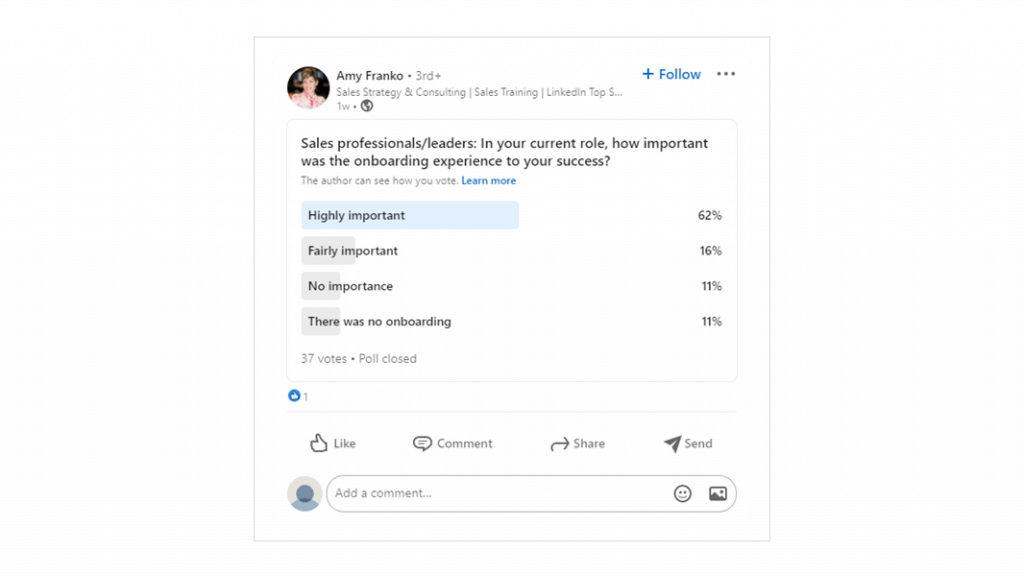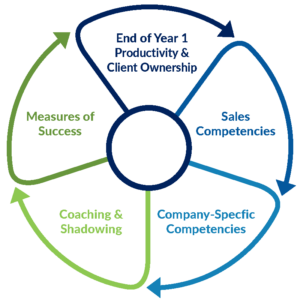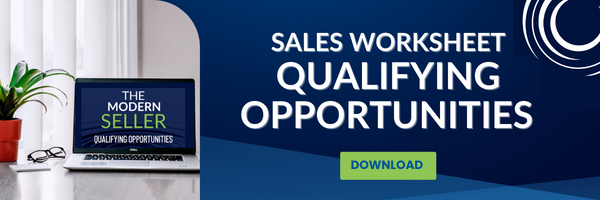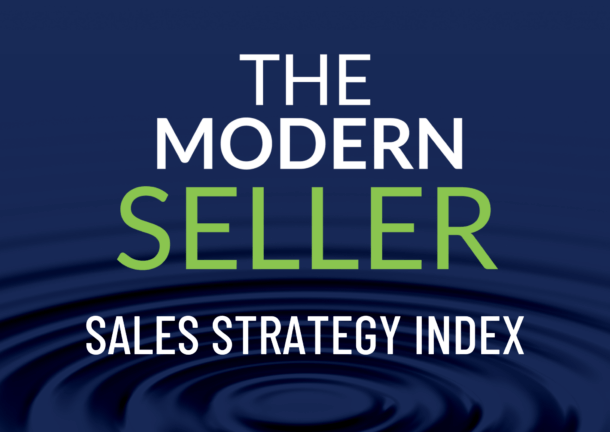In a LinkedIn poll I asked my community of sales leaders and sales professionals about the importance on their sales onboarding experience to their success. 62% found it highly important, while 16% found it fairly important, and 22% said that it either had no importance or didn’t exist as part of sales training. While some companies are getting it right, 38% of you are saying there is room for improvement. Today’s hiring environments are shining a light on the two sales structures your organization needs to create and keep a high-performing sales team: hiring strategy and onboarding strategy. 
Sales leaders ask, “It has been six months. Why is my sales professional not successful yet?”
When a sales professional isn’t successful, there are typically a few culprits: the role is the wrong fit, the role was misrepresented in the hiring process (for example, you really need a hunter skillset but the role reads more like an account manager), lack of commitment from the sales professional, lack of commitment from leadership, poor sales training, and poor sales structures. There are two other scenarios I commonly see:
- One is leaving a sales professional with complete autonomy over their sales planning strategy and activities out of the gate, even experienced professionals.
- Two is not allowing enough time for a professional to become truly productive.
A Sales Management Association study found that it can take up to one year (11.2 months) for a new sales professional to reach optimal productivity. Considering your hire’s total compensation package and other budgeted expenses (training, travel, etc.), this suggests that the first year is an investment year. That investment needs to pay off in a return over the next 1-5 years, depending on the complexity of the role.
The Visible (and Invisible) Costs of Poor Hiring and Sales Onboarding Strategies in Sales Training
Success or failure begins with sales hiring and then extends through sales onboarding. They make the difference between a productive, engaged sales professional who is a right fit for the role and contributes to your sales growth, or one that’s no longer with your organization after six months. As a sales leader in the latter situation, you’re unhappy because you’re now beginning again in a very challenging hiring market. The sales professional is unhappy with the experience and how has a short-term stay on their resume. They may be actively sharing that sentiment on platforms like Glass Door, which can then come full circle with a negative impact on your future hiring. The cost of poor onboarding per sales professional is nearly $200,000 (USD). Consider these data points. You can also use your own data for a sharper understanding of what this is costing you.
- According to a DePaul University study it costs, on average, $97,960 to replace a sales professional.
- Sirius Decisions (now Forrester) cites the opportunity cost of poor onboarding, or potential lost business, to be at $100,000 per sales professional.
A Sales Onboarding Model for High-Performing Sales Organizations
To create a successful sales onboarding model and sales training, it helps to connect onboarding to the other elements of high-performing organizations.
- Team Structure: The overall structure of the sales organization, accounting for all roles and leadership reporting.
- Role Design: Each role within the team is defined with specific characteristics, strategic and tactical expectations, and measures of success. This is the basis of hiring and assessing your sales talent.
- Hiring Strategy: Your go to market strategy that includes marketing of the position, candidate assessment, interviewing, compensation planning and final offers.
- Onboarding Strategy: Your overall approach for ensuring a successful entry into the organization that can extend to their first 6-12 months.
- Leadership Coaching & Accountability: Your approach to sales leadership’s role in sales coaching, guiding, and maintaining accountability to measures of success for your new hire, as well as a cultivating a growth culture.
Key Questions to Improve Your Sales Onboarding Approach
The rest of this piece will focus in on the sales-related elements of your onboarding approach and assumes you’re covering the basics like HR policies, equipment, systems, and other company-specific requirements. While onboarding programs will all have common elements, a tailoring approach makes sure each person’s experience and skills are considered. Below are some strategic questions you can ask of every new hire or hiring class:
- What is the anticipated time to productivity for the sales professional?
- What ways can we adapt our strategy to fit for virtual?
- What are their strengths and weaknesses as it relates to key sales skills? If you’re using a data-driven assessment approach this will make your analysis that much easier.
- What are the content themes we need to address? This includes selling skills, product knowledge, industry knowledge, and customer-base knowledge.
- Who from our organization will be instrumental in their success? These groups could include top-performing sellers, sales leaders, company leaders, solutions teams, channel partners, and customer service.
- What are the measures of success we will track? How often will we adjust those measures based upon results? What coaching will be provided along the way?
- What structures will they need? These include knowledge of the company’s strategies, access to and learning your tech stack, and an understanding of internal processes.
- What is the handoff point for true client ownership?

A Sales Onboarding Model You Can Tailor in Sales Training
My model assumes a one-year ramp to true productivity and client ownership. You have some latitude here based on the sales professional’s specific skills and experience. Below are the themes you will want to design for, along with your timing and metrics. A visual roadmap to year 1 readiness can be a helpful tool that is revisited by sales leaders, sales professionals, and other supporting team members. Selling Competencies: The key selling competencies they will need to ultimately demonstrate, as outlined by the role. Solution, Industry, and Customer Competencies: Your company-specific knowledge they will need to master. Common examples are the understanding of key sales situations or mastery of a customer demo. Coaching & Shadowing: I can personally attest to the power of shadowing. Early in my career I spent time with two very successful sellers who not only modeled success, they very much impacted my love of the career as a whole. Regular coaching cadence with the direct sales leader, and then shadowing opportunities (whether in-person or virtual), are a critical component. Measures of Success: This includes defining what success will look like at each quarter and then over the full picture of the first year. Your leading indicators are important, because at this point in time there are no lagging indicators (for example, quota attainment). An agreed to set of meaningful sales activities and progress are excellent places to begin. You’ll also gauge early on how committed your sales professional is to the process and working through obstacles.
Need a Fresh Perspective On Your Sales Hiring and Onboarding Strategy? We can help.
Don’t let your competition get an advantage. We can help elevate your team. If you want to know how to improve your sales onboarding, or you’d like to bring in an outside perspective, let’s talk. Contact us to schedule time for a discovery conversation.




 Our Strategic Selling signature sales training program is now available online. This online sales learning program is ideal for professional services and B2B sales. Get started with 2 free lessons.
Our Strategic Selling signature sales training program is now available online. This online sales learning program is ideal for professional services and B2B sales. Get started with 2 free lessons.